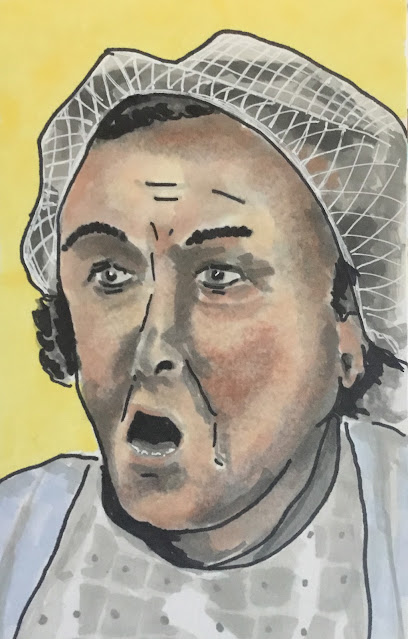A couple of days ago, I prepared the shelf. First, I sanded it down. Then I applied watercolour ground over bits of it, with a bit of gesso in places. I wanted to put on some crackle paste too but mine had all dried up, so I ground it up into little pieces and patted it into the watercolour ground. The crackle paste is generally spread between bottom left and the centre. The bottom right corner has some interesting textures from pushing down a mandarin net bag into the watercolour ground. Gesso is generally around the top left and there are some textures in the top right from pressing on some French stick wrappers. After leaving it a couple of days to dry, I was left with this:
Today I've been painting the shelf. I started by dividing it into warm and cool areas. The warm area is the most bumpy area, between the middle and the bottom left. The rest, cupped around it, is the cool area. For the cool area, I used my three cool blues (Prussian, Mayan and cerulean), my two greens (viridian and apatite genuine) and one of my cool yellows (transparent yellow). I stuck to blues in the top left, where’s the surface was smoother and it could be turned into sky, but otherwise went for a mix of greens. For the warm area, I used my warm reds (Rose dore and Winsor) and my warm yellow (Indian). I needed to do some watering and tipping to get the warm and cool colours to run into each other at their common boundary but that happens when you don't use watercolour paper.
Next I made a big mistake. I put on some acrylic inks and granulation medium. This combination produces great effects on watercolour paper but not on this sort of surface. I was hoping the inks would help bring out some of the textures on the surface but they refused and even started turning to mud. So I dabbed out as much of the ink as possible and reapplied watercolour everywhere except the sky area, which was untainted by the inks.
I tried using cadmium yellow to paint the tips of hills and ridges on the paper but without any luck: it kept rolling down into the valleys, so I gave up and dabbed out as much of the cadmium yellow as I could.
I found some strange effects going on along the bottom of the sky when I was trying to dab out the white inks. I ended up with some greys that started to look like an animal climbing a tree. So I decided that this was the way the painting was going. I should probably point out that this was an animal that emerged from some abstract noodling, rather than an animal that was inspired by that Jean Haines book. Anyway, after several attempts at a purple, orange or grey colour scheme I ended up with the blue/purple shape you see here. Quinacridone magenta and hematite violet genuine have joined all the existing colours here. I used sepia to bring out some features on the animal but then also tried to blend the animal into the sky at its back end.
To finish, I added white highlights in places and a spattering of titanium white, cadmium red and cadmium yellow over everywhere except the sky. Tomorrow, I'll spray the painting with a preservative.
Overall it's interesting but not a winner. I didn't put this one up for sale but the plan was to let my Dad have it if he wanted it. There were too many mistakes in the process on this one, most of them to do with being too impatient to let coats dry and instead dabbing at them with kitchen paper. The animal is interesting but has too weird a shaped head for my liking. And there's a white spatter just above and to the right of its right eye that looks like the eye is in the wrong place. I like, though, the sweep of colour just below the head that could be either a front leg or a feature of the branch.
The name for this one comes from an Algernon Blackwood short story but there were a couple of Jimi Hendrix tracks that might have made good alternatives.
But the real question is what the animal is. Is it a rat, a cat, a panther, a bush baby, a human being, something else? I've no idea.
Later edit: The painting has gone now. It lived in the boot of my car for a few weeks and was there when I visited my Dad on his last day in this world at Bedford Hospital on 10 February 2022. With the gifting opportunity gone, I decided I didn't want to keep the painting but, rather than throwing it away, stood it next to a bin at the hospital car park. Maybe someone might like it and take it away.


















